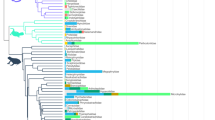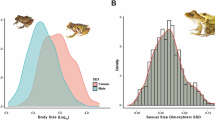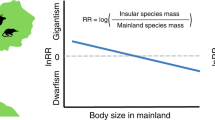Abstract
The evolution and great diversity of genome size has been of long-standing interest to biologists, but has seldom been investigated on a broad phylogenetic scale. Here we present a comparative quantitative analysis of factors shaping genome size evolution in amphibians, the extant class of vertebrates with the largest variation in genome size. We find that amphibian genomes have undergone saltations in size, although these are rare and the evolutionary history of genome size in amphibians has otherwise been one of gradual, time-dependent variation (that is, Brownian motion). This macroevolutionary homogeneity is remarkable given the evolutionary and ecological diversity of most other aspects of the natural history of amphibians. Contrary to previous claims, we find no evidence for associations between life cycle complexity and genome size despite the high diversity of reproductive modes and the multiple events of independent evolution of divergent life cycles in the group. Climate (temperature and humidity) affects genome size indirectly, at least in frogs, as a consequence of its effect on premetamorphic developmental period, although directionality of the relationship between developmental period and genome size is not unequivocal.
This is a preview of subscription content, access via your institution
Access options
Access Nature and 54 other Nature Portfolio journals
Get Nature+, our best-value online-access subscription
$29.99 / 30 days
cancel any time
Subscribe to this journal
Receive 12 digital issues and online access to articles
$119.00 per year
only $9.92 per issue
Buy this article
- Purchase on Springer Link
- Instant access to full article PDF
Prices may be subject to local taxes which are calculated during checkout




Similar content being viewed by others
Data availability
All genome size measurements generated for this study are available in the supplementary information.
References
Mirsky, A. E. & Ris, H. The desoxyribonucleic acid content of animal cells and its evolutionary significance. J. Gen. Physiol. 34, 451–462 (1951).
Thomas, C. A. The genetic organization of chromosomes. Annu. Rev. Genet. 5, 237–256 (1971).
Lynch, M. The Origins of Genome Architecture (Sinauer Associates, Sunderland, 2007).
Lynch, M. & Conery, J. S. The origins of genome complexity. Science 302, 1401–1404 (2003).
Gregory, T. R. Coincidence, coevolution, or causation? DNA content, cell size, and the C-value enigma. Biol. Rev. Camb. Philos. Soc. 76, 65–101 (2001).
Elliott, T. A. & Gregory, T. R. What's in a genome? The C-value enigma and the evolution of eukaryotic genome content. Phil. Trans. R. Soc. B 370, 20140331-10 (2015).
Olmo, E., Capriglione, T. & Odierna, G. Genome size evolution in vertebrates: trends and constraints. Comp. Biochem. Phys. C 92B, 447–453 (1989).
Kang, M. et al. Adaptive and nonadaptive genome size evolution in Karst endemic flora of China. New. Phytol. 202, 1371–1381 (2014).
Petrov, D. A. Evolution of genome size: new approaches to an old problem. Trends Genet. 17, 23–28 (2001).
Whitney, K. D. & Garland, T. Did genetic drift drive increases in genome complexity? PLoS Genet. 6, e1001080 (2010).
Lynch, M. Statistical inference on the mechanisms of genome evolution. PLoS Genet. 7(6), e1001389 (2011).
Gregory, T. R. (ed.) The Evolution of the Genome (Academic/Elsevier, Burlington, 2005).
Ogata, H., Fujibuchi, W. & Kanehisa, M. The size differences among mammalian introns are due to the accumulation of small deletions. FEBS Lett. 390, 99–103 (1996).
Sun, C., Lopez Arriaza, J. R. & Mueller, R. L. Slow DNA loss in the gigantic genomes of salamanders. Genome Biol. Evol. 4, 1340–1348 (2012).
Smith, J. J. et al. Genic regions of a large salamander genome contain long introns and novel genes. BMC Genomics 10, 19–11 (2009).
Schlötterer, C. & Harr, B. Drosophila virilis has long and highly polymorphic microsatellites. Mol. Biol. Evol. 17, 1641–1646 (2000).
Tenaillon, M. I., Hollister, J. D. & Gaut, B. S. A triptych of the evolution of plant transposable elements. Trends Plant Sci. 15, 471–478 (2010).
Sun, C. & Mueller, R. L. Hellbender genome sequences shed light on genomic expansion at the base of crown salamanders. Genome Biol. Evol. 6, 1818–1829 (2014).
Sun, C. et al. LTR retrotransposons contribute to genomic gigantism in plethodontid salamanders. Genome Biol. Evol. 4, 168–183 (2012).
Kapusta, A., Suh, A. & Feschotte, C. Dynamics of genome size evolution in birds and mammals. Proc. Natl Acad. Sci. USA 114, E1460–E1469 (2017).
Crollius, H. R. et al. Characterization and repeat analysis of the compact genome of the freshwater pufferfish Tetraodon nigroviridis. Genome Res. 10, 939–949 (2000).
Lower, S. S. et al. Genome size in North American fireflies: substantial variation likely driven by neutral processes. Genome Biol. Evol. 9, 1499–1512 (2017).
Lefébure, T. et al. Less effective selection leads to larger genomes. Genome Res. 27, 1016–1028 (2017).
Talla, V. et al. Rapid increase in genome size as a consequence of transposable element hyperactivity in Wood-White (Leptidea) butterflies. Genome Biol. Evol. 9, 2491–2505 (2017).
Olmo, E. & Morescalchi, A. Genome and cell sizes in frogs: a comparison with salamanders. Experientia 34, 44–46 (1978).
Gregory, T. R. The bigger the C-value, the larger the cell: genome size and red blood cell size in vertebrates. Blood Cell Mol. Dis. 27, 830–843 (2001).
Guignard, M. S. et al. Genome size and ploidy influence angiosperm species’ biomass under nitrogen and phosphorus limitation. New Phytol. 210, 1195–1206 (2016).
Gregory, T. R. Genome size and developmental complexity. Genetica 115, 131–146 (2002).
Vinogradov, A. E. Nucleotypic effect in homeotherms: body-mass independent resting metabolic rate of passerine birds is related to genome size. Evolution 51, 220–225 (1997).
Sessions, S. K. & Larson, A. Developmental correlates of genome size in Plethodontid salamanders and their implications for genome evolution. Evolution 41, 1239–1251 (1987).
Jockusch, E. L. An evolutionary correlate of genome size change in plethodontid salamanders. Proc. R. Soc. Lond. B 264, 597–604 (1997).
Wyngaard, G. A., Rasch, E. M., Manning, N. M., Gasser, K. & Domangue, R. The relationship between genome size, development rate, and body size in copepods. Hydrobiologia 532, 123–137 (2005).
Alfsnes, K., Leinaas, H. P. & Hessen, D. O. Genome size in arthropods; different roles of phylogeny, habitat and life history in insects and crustaceans. Ecol. Evol. 44, 498–499 (2017).
Xia, X. Body temperature, rate of biosynthesis, and evolution of genome size. Mol. Biol. Evol. 12, 834–842 (1995).
Wells, K. D. The Ecology and Behavior of Amphibians (Univ. Chicago Press, Chicago, 2007).
Gomez-Mestre, I., Pyron, R. A. & Wiens, J. J. Phylogenetic analyses reveal unexpected patterns in the evolution of reproductive modes in frogs. Evolution 66, 3687–3700 (2012).
Mohlhenrich, E. R. & Mueller, R. L. Genetic drift and mutational hazard in the evolution of salamander genomic gigantism. Evolution 70, 2865–2878 (2016).
Bennett, M. D., Lewis, R. K. & Harbert, D. J. The time and duration of meiosis. Phil. Trans. R. Soc. Lond. B 277, 201–226 (1977).
Knight, C. A. & Ackerly, D. D. Variation in nuclear DNA content across environmental gradients: a quantile regression analysis. Ecol. Lett. 5, 66–76 (2002).
White, M. M. & McLaren, I. A. Copepod development rates in relation to genome size and 18S rDNA copy number. Génome 43, 750–755 (2000).
Camper, J. D., Ruedas, L. A., Bickham, J. W. & Dixon, J. R. The relationship of genome size with developmental rates and reproductive strategies in five families of neotropical bufonoid frogs. Genetics 12, 79–87 (1993).
Wilkinson, M., San Mauro, D., Sherratt, E. & Gower, D. J. A nine-family classification of caecilians (Amphibia: Gymnophiona). Zootaxa 2874, 41–64 (2011).
Kamei, R. G. et al. Discovery of a new family of amphibians from northeast India with ancient links to Africa. Proc. Biol. Sci. 279, 2396–2401 (2012).
Khabbazian, M., Kriebel, R., Rohe, K. & Ané, C. Fast and accurate detection of evolutionary shifts in Ornstein–Uhlenbeck models. Methods Ecol. Evol. 7, 811–824 (2016).
Clavel, J., Escarguel, G. & Merceron, G. mvMORPH: an R package for fitting multivariate evolutionary models to morphometric data. Methods Ecol. Evol. 6, 1311–1319 (2015).
Rabosky, D. L. Automatic detection of key innovations, rate shifts, and diversity-dependence on phylogenetic trees. PLoS One 9, e89543 (2014).
Harmon, L. J., Weir, J. T., Brock, C. D., Glor, R. E. & Challenger, W. GEIGER: investigating evolutionary radiations. Bioinformatics 24, 129–131 (2008).
Duchen, P. et al. Inference of evolutionary jumps in large phylogenies using Levy processes. Syst. Biol. 66, 950–963 (2017).
Gonzalez-Voyer, A. & Hardenberg, A. V. Modern Phylogenetic Comparative Methods and their Application in Evolutionary Biology (ed. Garamszegi, L. Z.) 201–229 (Springer, Berlin, 2014).
Thomson, K. S. & Muraszko, K. Estimation of cell-size and DNA content in fossil fishes and amphibians. J. Exp. Zool. 205, 315–320 (1978).
Chipman, A. D., Khaner, O., Haas, A. & Tchernov, E. The evolution of genome size: what can be learned from anuran development? J. Exp. Zool. 291, 365–374 (2001).
Laurin, M., Canoville, A., Struble, M., Organ, C. & de Buffrénil, V. Early genome size increase in urodeles. CR Palevol. 15, 74–82 (2016).
Canapa, A., Barucca, M., Biscotti, M. A., Forconi, M. & Olmo, E. Transposons, genome size, and evolutionary insights in animals. Cytogenet. Genome. Res. 147, 217–239 (2016).
Pagel, M. & Johnstone, R. A. Variation across species in the size of the nuclear genome supports the junk-DNA explanation for the C-value paradox. Proc. Biol. Sci. 249, 119–124 (1992).
Zeng, C., Gomez-Mestre, I. & Wiens, J. J. Evolution of rapid development in spadefoot toads is unrelated to arid environments. PLoS One 9, e96637 (2014).
Lynch, M., Bobay, L.-M., Catania, F., Gout, J.-F. & Rho, M. The repatterning of eukaryotic genomes by random genetic drift. Annu. Rev. Genom. Hum. Genet. 12, 347–366 (2011).
Evans, T., Wade, C. M., Chapman, F. A., Johnson, A. D. & Loose, M. Acquisition of germ plasm accelerates vertebrate evolution. Science 344, 200–203 (2014).
Romiguier, J. et al. Comparative population genomics in animals uncovers the determinants of genetic diversity. Nature 515, 261–263 (2014).
Chrtek, J. I. Jr, Zahradnek, J., Krak, K. & Fehrer, J. Genome size in Hieracium subgenus Hieracium (Asteraceae) is strongly correlated with major phylogenetic groups. Ann. Bot. 104, 161–178 (2009).
Weiss-Schneeweiss, H., Greilhuber, J. & Schneeweiss, G. M. Genome size evolution in holoparasitic Orobanche (Orobanchaceae) and related genera. Am. J. Bot. 93, 148–156 (2006).
Leitch, I. J. et al. Punctuated genome size evolution in Liliaceae. J. Evol. Biol. 20, 2296–2308 (2007).
Johnston, J. S. et al. Evolution of genome size in Brassicaceae. Ann. Bot. 95, 229–235 (2005).
Van de Peer, Y., Maere, S. & Meyer, A. The evolutionary significance of ancient genome duplications. Nat. Rev. Genet. 10, 725–732 (2009).
Sanmiguel, P. & Bennetzen, J. L. Evidence that a recent increase in maize genome size was caused by the massive amplification of intergene retrotransposons. Ann. Bot. 82, 37–44 (1998).
Pyron, R. A. Biogeographic analysis reveals ancient continental vicariance and recent oceanic dispersal in amphibians. Syst. Biol. 63, 779–797 (2014).
Frost, D. R. Amphibian Species of the World: An Online Reference Version 6.0 (American Museum of Natural History, New York, 2018); http://research.amnh.org/herpetology/amphibia/index.html
Hardie, D. C., Gregory, T. R. & Hebert, P. D. N. From pixels to picograms: a beginners’ guide to genome quantification by Feulgen image analysis densitometry. J. Histochem. Cytochem. 50, 735–749 (2002).
Bivand, R. S., Pebesma, E. & Gómez-Rubio, V. Applied Spatial Data Analysis with R (Springer, New York, 2013).
Hijmans, R. J. raster: Geographic Data Analysis and Modeling R Package Version 2.5-8 (2016); https://CRAN.R-project.org/package=raster
Bivand, R. S. & Lewin-Koh, N. maptools: Tools for Reading and Handling Spatial Objects R Package Version 0.9-2 (2017); https://CRAN.R-project.org/package=maptools
Jeffery, N. W. & Gregory, T. R. Genome size estimates for crustaceans using Feulgen image analysis densitometry of ethanol-preserved tissues. Cytometry 85, 862–868 (2014).
Schindelin, J. et al. Fiji: an open-source platform for biological-image analysis. Nat. Methods 9, 676–682 (2012).
Revell, L. J. phytools: an R package for phylogenetic comparative biology (and other things). Methods Ecol. Evol. 3, 217–223 (2012).
Rabosky, D. L. et al. BAMMtools: an R package for the analysis of evolutionary dynamics on phylogenetic trees. Methods Ecol. Evol. 5, 701–707 (2014).
Plummer, M., Best, N., Cowles, K. & Vines, K. CODA: convergence diagnosis and output analysis for MCMC. R News 6, 7–11 (2006).
van der Bijl, W. phylopath: easy phylogenetic path analysis in R. PeerJ 6, e4718 (2018).
San Mauro, D. et al. Life-history evolution and mitogenomic phylogeny of caecilian amphibians. Mol. Phylogenet. Evol. 73, 177–189 (2014).
Acknowledgements
We would like to thank C. Spencer at the Museum of Vertebrate Zoology (Berkeley), M.-O. Rödel and F. Tillack at the Museum für Naturkunde (Berlin), S. Loader and J. Streicher at the Natural History Museum (London), B. Alvarez and I. Martinez-Solano at the Museo Nacional de Ciencias Naturales (Madrid), V. Gvoždík at the Academy of Sciences (Brno) for tissue loans and L. Asencio Vazquez for assistance with laboratory work. M.W. and D.J.G. thank the many persons and organizations that have facilitated the collection of caecilian materials used in this work, especially S. Maddock and the Direction de l’Environment, de l’Aménagement et du Logement and the Conseil Scientifique Régional du Patrimonie Naturel (Guyane). Funding was provided by Spanish National Research Plan (CGL2017-83407-P) awarded to I.G.-M., Swiss National Science Fund (P2BSP3_158846) awarded to H.C.L. and the Darwin Initiative (19-002) awarded to D.J.G.
Author information
Authors and Affiliations
Contributions
H.C.L., I.G.-M., D.J.G. and M.W. were all involved in planning and executing the project. D.J.G. and M.W. contributed key samples and H.C.L. obtained de novo genome size estimates and performed data analyses with input from I.G.-M. H.C.L. wrote the first version of the manuscript, to which all other authors thereafter contributed.
Corresponding author
Ethics declarations
Competing interests
The authors declare no competing financial interests.
Additional information
Publisher’s note: Springer Nature remains neutral with regard to jurisdictional claims in published maps and institutional affiliations.
Supplementary information
Supplementary information
Supplementary tables and figures
Supplementary Data 1
Supplementary information in tabular form
Rights and permissions
About this article
Cite this article
Liedtke, H.C., Gower, D.J., Wilkinson, M. et al. Macroevolutionary shift in the size of amphibian genomes and the role of life history and climate. Nat Ecol Evol 2, 1792–1799 (2018). https://doi.org/10.1038/s41559-018-0674-4
Received:
Accepted:
Published:
Issue Date:
DOI: https://doi.org/10.1038/s41559-018-0674-4
This article is cited by
-
Multi-omics resources for the Australian southern stuttering frog (Mixophyes australis) reveal assorted antimicrobial peptides
Scientific Reports (2024)
-
Integrating genomics into the genetic management of the endangered mountain yellow-legged frog
Conservation Genetics (2024)
-
Climate change from an ectotherm perspective: evolutionary consequences and demographic change in amphibian and reptilian populations
Biodiversity and Conservation (2024)
-
Ecological factors and parity mode correlate with genome size variation in squamate reptiles
BMC Ecology and Evolution (2023)
-
Comparative genomics reveals insights into anuran genome size evolution
BMC Genomics (2023)



